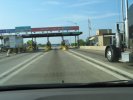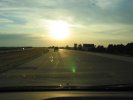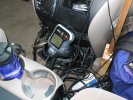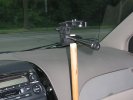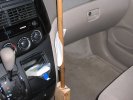The Sancho Games crew headed off to Origins 2005 for four days of Live Roleplaying Chess, crawling the exhibit hall, and buying wacky French games about King Arthur. Along the way, we took some pictures and made some videos. If you've ever wondered what the trip from Madison, Wisconsin to Columbus, Ohio and back looks like at over 10,000MPH, this is your chance to find out.
On the way down to Origins, we took 640 x 480 photos out the front window every 5 seconds, and spliced them together into a four minute mpeg4 video. This results in a speedup of 150x, or an apparent cruising speed of just over 11,000mph. A scaled version of the movie (45MB) is online for your viewing pleasure. I particularly recommend the rain sequences about 2/3 of the way through the movie. On a second viewing, watch the clouds move and evolve.
On the way back from Origins, we took 1024 x 768 photos out the front window every 5 seconds and moviefied them. The result requires a 1.5-2.0GHz Athlon to play back at full speed, and is 200MB in size. The scaled web movie (44MB) version should be happy with rather slower machines. The long exposures after dark result in considerable motion blur, as the camera tries in vain to collect enough light, but the effect is interesting.
How we Did It
Update - We changed the mounting system for Gencon, and it's much more stable. More details in the Gencon 2005 section.
These movies were made with a Canon G2 camera and the Canon RemoteCapture software dumping frames every 5 seconds (the current version's maximum framerate - older versions go down to 3 seconds) to a Thinkpad, both powered through an inverter and a mess of cables. The camera was mounted on a cheap tripod head mounted to a stick held more-or-less in place in the front of the van. The tripod head has a quick-release plate on it, which is nice if you don't want the camera making your car a break-in target while you're in a restaurant.
The SlideShow Movie Maker software (link updated June 2006) was used to assemble the still frames into an mpeg4 movie using Microsoft's MPEG4 version 2 CODEC. Version 3 did not work, and divx 5.something resulted in all-black frames. I've used divx before and had it work but decided not to investigate further, as the MS codec was working fine. SSMM was clearly not intended for this use, as it errors out when trying to import more than about 1500 images at a time, though it is happy to have you import more than that in batches. The full-sized movies are encoded at 3Mbit for the trip down, and 6Mbit on the way back. This would be horrible overkill were these traditional movies, but since each frame differs so much from the one before and the one after, compression artifacts are visible even at these high bitrates. The web versions of these movies are encoded at 1.5Mbit.
Update - The error is not with SSMM per se, but rather with the Windows multiple-file-select dialog box, which uses a 32KB input buffer, truncating input longer than that. SSMM generates an error because the last file name gets truncated, resulting in a filename which does not exist.
We were plagued with a few first-time technical difficulties, and lost some frames as a result. Note: don't turn the camera off when the software's trying to take pictures - it wedges Windows hard. The missing frames don't seem to detract from the video because of its high speed, but we now know how to avoid it, and should have clearer movies from Gencon in August. Also, we did not want to present a tasty theft target, so we did not leave the camera sitting in its mount when we stopped for meals. The visible stops are rest stops, where someone was in or around the van at all times, or gas stations. In the future, it would be nice to use a less appealing camera so it could safely be left on. The camera beeps with every shot taken, which is somewhat annoying, but served us well as it quickly alerted us to problems that we were having. Newer cameras seem not to beep (at least, the A70 doesn't), but for a variety of reasons the G2 was the best camera for us this trip. The camera mount could be improved in a couple of ways, but the shaking that results from road vibrations can't be helped. This is clearly visible when looking at the dash in the lower left of the frames, but does not detract from the video's effect, in the humble opinion of the movie's director:)
